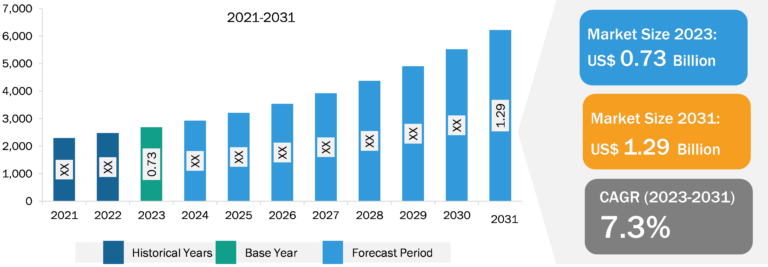
Ultrasound-enhancing agents Market
Factors Driving Ultrasound-enhancing Agents Market Growth
Ultrasound imaging is currently the first step in estimating the severity of oncological diseases and cardiovascular conditions, paving the way for accurate assessment and diagnosis through further investigation. It is widely used for real-time imaging of body parts for the detection of abnormalities due to the portability, low cost, safety, and diagnostic capabilities of the system. In addition, using contrast agents has significantly improved the sensitivity and specificity of ultrasound for detecting earlier stages of diseases, thus opening up new possibilities for cellular and molecular research in this field. The surging prevalence of chronic diseases such as cancer, kidney diseases, and liver disorders propels the demand for early diagnoses for better management. Their diagnoses necessitate advanced imaging modalities for early detection and health monitoring among diagnosed patients. Ultrasound enhancing agents enable enhanced visualization of tumors, lesions, and abnormal tissue growth. According to an article published in radiopaedia.org in September 2023, Sonazoid, a contrast agent used in ultrasound imaging, enhances the liver’s contrast in the postvascular phase, which can help detect liver tumors, especially those without Kupffer cell metastases. Sonazoid also helps differentiate between regenerative and dysplastic nodules from early-phase hepatocellular carcinomas in a cirrhotic liver. Therefore, the rising adoption of UCAs in diagnostic imaging boosts the ultrasound enhancing agents market size.
According to an article published in October 2021 by the International Contrast Ultrasound Society (ICUS), 57 original research studies focused solely on pediatric patients, including 4,518 children who underwent 4,906 intravenous contrast-enhanced ultrasound examinations as of August 2021. Additionally, comprehensive protocols developed to evaluate clinical safety demonstrated the highly favorable safety profile of UCAs when used intravenously, intravesically, and through other intracavitary procedures.

Market Trends:
Rising focus on the development of improved formulations with enhanced stability, longer circulation times, and targeted binding properties is likely to add novel products to the market. Recent advancements in contrast agents have revolutionized the field of cellular and molecular imaging, enhancing the accuracy of early-stage disease detection. The use of nanoparticles with suitable structures and superior binding capabilities facilitates targeted imaging and disease detection. Such ultrasound-enhancing agents can be built by designing acoustically sensitive agents for disease-specific imaging, developing signal processing techniques to obtain high-resolution vascular images, and creating interpretation techniques to extract biologically and physiologically relevant data from microbubble acoustic signatures. The emergence of new ultrafast imaging and image processing techniques, coupled with the growing interest in targeted ultrasound therapeutic applications, are likely to support the use of ultrasound in numerous unexplored applications. The signal of agents depends on their size, and currently, the market is dominated by large-sized agents. This limits their use in molecular imaging, including cancer detection. However, smaller agents (100–500 nm) are being developed using nanomedicine. These agents can utilize tumor permeability and expand the capabilities of ultrasound in targeted cancer detection and therapy.
Further, improvements in pediatric ultrasound imaging techniques, including ultrasound-enhancing agents, are anticipated to cater to the specific needs of pediatric patients. The introduction of child-friendly contrast-enhancing agents, dose-optimization strategies, and personalized imaging protocols may address the unique challenges associated with imaging in pediatrics, in turn ensuring the safety and efficacy of diagnostics.
In terms of geography, the ultrasound-enhancing agents market is divided into North America (the US, Canada, and Mexico), Europe (Spain, the UK, Germany, France, Italy, and the Rest of Europe), Asia Pacific (South Korea, China, India, Japan, Australia, and the Rest of Asia Pacific), the Middle East & Africa (South Africa, Saudi Arabia, the UAE, and the Rest of Middle East & Africa), and South & Central America (Brazil, Argentina, and the Rest of South & Central America). Asia Pacific is expected to register the fastest CAGR in the ultrasound-enhancing agents market during the forecast period.
Ultrasound-Enhancing Agents Market: Segmental Overview
By type, the market is bifurcated into first generation and second generation. The second generation segment held a larger market share in 2023. It is projected to register a higher CAGR from 2023 to 2031.
The market, by application, is segmented into abdominal imaging, cardiovascular imaging, urinary tract imaging, and others. The abdominal imaging segment held the largest ultrasound-enhancing agents market share in 2023. The market, by end user, is segmented into hospitals, diagnostic and imaging centers, and others. The hospitals segment accounted for the largest share of the market in 2023.
Ultrasound-Enhancing Agents Market: Competitive Landscape and Key Developments
Lantheus Holdings Inc.; GE Healthcare; Solstice Pharmaceuticals BV; FUJIFILM VisualSonics, Inc.; Bracco Diagnostics Inc.; Bayer AG; and Vesselon are among the leading companies profiled in the ultrasound-enhancing agents market report. In addition, several other players have been studied and analyzed during the study to get a holistic view of the market and its ecosystem. The market players mainly adopt product innovation strategies to meet evolving customer demands and maintain their brand image.
As per company press releases, a few recent developments by players operating in the ultrasound-enhancing agents market are mentioned below:
In March 2024, Lantheus Holdings, Inc. announced the approval of the US Food and Drug Administration (FDA) for its supplemental new drug application (sNDA) for DEFINITY for its use as an ultrasound-enhancing agent in pediatric patients producing suboptimal echocardiograms.
In March 2024, Samsung Medison and Bracco Imaging endorsed a Memorandum of Understanding (MoU) agreement to develop a new area for diagnostic ultrasound devices and contrast agents at the European Congress of Radiology (ECR) 2024, held between February 28 to March 3 in Vienna, Austria. Two companies are considering collaborating to develop high-frequency and super-resolution imaging protocols for diagnosis. The collaboration would also include marketing activities, healthcare providers’ education, and exploration of ultrasound-targeted contrast-enhanced drug delivery technologies with pharmaceutical agents.
In April 2023, GE HealthCare launched Pixxoscan (Gadobutrol). It is a macrocyclic, gadolinium-based contrast agent (GBCA) for nonionic magnetic resonance imaging. The product was added to the company’s MRI contrast media portfolio, which includes Claiscan (macrocyclic gadoteric acid) and Rapiscan (used in stress cardiac MR to aid diagnosis of coronary artery disease).







